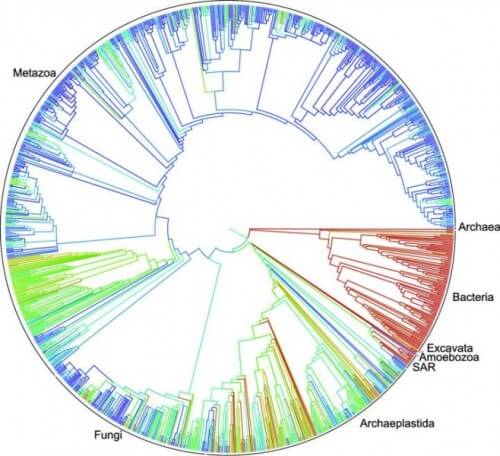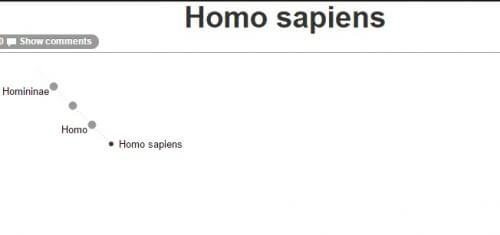It is a joint effort by researchers from 11 universities to develop a shimpa tree, the connections between the living things that diverged from each other over the years, starting with the beginning of life 3.5 billion years ago

Researchers have recently developed the first online edition of the Tree of Life containing all 2.3 million scientifically named species of all living things - animals, plants, fungi, and microbes (bacteria and archaea).
The pie chart depicts the tree of all life forms over the entire history of the 3.5 billion years since life first arose, and how it evolved and diversified. Figure: Credit: opentreeoflife.org
It is a joint effort by researchers from 11 universities to develop a shimpa tree of the connections between the living things that diverged from each other over the years, starting with the beginning of life 3.5 billion years ago.

Tens of thousands of smaller trees have been published over the years for selected branches of the tree of life, some containing up to a hundred thousand species, but this is the first time that these findings have been combined together to create one tree that includes all life forms.
The end result is a digital database, available for anyone to use or edit, a sort of "Wikipedia" of the evolutionary relationships between the species.
This is the first time that a real effort has been made to collect all the points and combine them together" says the main researcher in the project Karen Cranson from Duke University. "Think of it as version 1.0," she added.
The current version of the tree together with the information and the source code are available for browsing and downloading In this link
The findings were also published on September 18 in the journal PNAS of the US National Academy of Sciences.
Evolutionary trees, branch diagrams that often look like a cross between a lamp and a subway map, aren't just for testing whether the anteater is closer to the mole or the manatee, or who the slime mold's closest cousin is. Understanding how millions of species are related to each other can help scientists discover new drugs, improve crops and farm animal productivity, and track the origins and spread of epidemics such as AIDS, Ebola and influenza.
Instead of rebuilding the tree of life, the researchers collected and processed thousands of smaller pieces that were already published and accessible on the Internet and merged them together into a kind of giant tree that combines all the species known to science and thus earned a scientific name.
The first version incorporates about 500 smaller trees published in previous studies. To map trees from different sources to the branches and trunks of a tree on one giant, one of the biggest challenges was to count the name changes, alternate names, common misspellings and abbreviations for each species' name. The eastern red rat for example is classified under two scientific names: Lasiurus borealis and Nycteris borealis. Spiny ants once shared a scientific name with a group of moray eels.
"Although this is a tremendous effort in its own right, the draft of the Tree of Life is only the first step," the researchers write. Currently, only a tiny fraction of the published trees are available digitally. Out of over 7,500 phylogenetic studies published between 2000 and 2012 in over a hundred journals, only one out of every six studies had their data in a format that researchers could use.
Most evolutionary trees have been published in PDF and others at image rates that cannot even be entered into their database or merged with other trees.

"There is a pretty big gap between the total amount of scientific knowledge about living species and the relationships between them and what is actually available digitally," says Cranson. Therefore, the relationships described in some parts of the tree such as the branches representing the pea and sunflower families, do not always correspond to the experts' opinion. Other parts of the tree, particularly those dealing with insects and microbes, are still elusive. This is because the largest online archives of raw genetic sequences – from which the evolutionary trees are derived – contain DNA data for less than five percent of the tens of millions of species living on Earth today.
Just as important as showing what we know about the relationship between the species, this first cheek tree is also important for revealing what we don't know, says Douglas Solits from the University of Florida, also one of the authors of the article.
To help fill the gap, the team members developed software that will help researchers in the field to enter, update and if necessary change the tree, as new data from fresh research accumulates, and thus it will be possible to build the tree even for millions of species that have not yet been named or even discovered.
"This is not a finished project," says Cranston. "It is essential to share data that has already been published and works that will be published further if we want to improve the tree.
"25 years ago the very goal of building a large tree of life was impossible" Soltis said. "The open tree of life is a starting point that other researchers can now update and improve in the coming decades."
The research was partially funded by the US National Science Foundation.
to the notice of the researchers
More of the topic in Hayadan:
Welcome to the family - putting order in the tree of human evolution
Sea lily - half plant, half animal

10 תגובות
On Yom Kippur at two in the morning
I don't see the time but the date is Yom Kippur.
Even without the date, it is likely to be a troll (and not one of the sophisticated ones)
I don't know about you, but I don't need a calendar and a clock to spot a troll. Nor a compass.
Although Tolkien claims that trolls turn to stone when the sun rises, this is only in Tolkien's world, and anyway he never met a real troll.
Avi,
The time does not appear on the website. I conclude from your response that it is before Kippur came out, but since I did not see when the response was entered, I do not know this. Are you implying that this is a troll?
Pay attention to the date and time of writing the response.
The only tree of life is the tree of life found in the Garden of Eden
The time has come for you to understand that the Holy One, blessed be He, created man from dust and breathed into him the spirit of life
How dare you write such nonsense
You will all be in hell
It would be really nice if they turned this tree into a XNUMXD computerized model that can be easily moved lengthwise and horizontally in different resolutions, with all the animals along the various branches also appearing in XNUMXD.
I think we did a similar project with a model of the universe a few years ago.
Nice video about the theory of evolution:
https://www.youtube.com/watch?v=lGZMxJhEbdc
I did not find a single virus
It is true that they are not defined as life, but they also have complex evolutionary trees
There is an error in the link to the tree